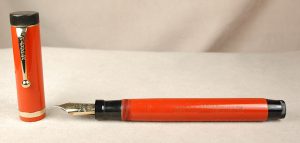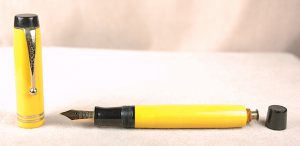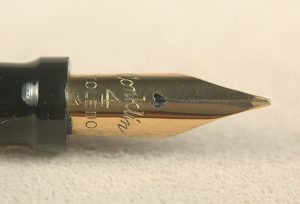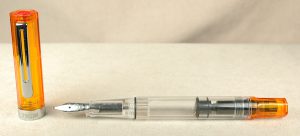Time and again, I’ve mentioned the fountain pen that got me hooked into this crazy lifestyle. It was my mother’s father’s Sheaffer Balance Lifetime. Yet, I have another grandparental pen that never gets much publicity. It is a Parker 51 from my father’s side of the family.
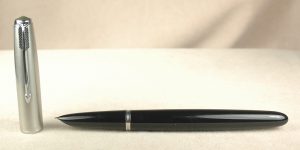
This Parker 51 once belonged to either my father’s mother or father. I suspect it was Granddad’s, but either way it is a treasured keepsake.
The Parker 51 showed up in my life about 15 years after the Sheaffer. It was right around the year 2000. My father’s mother was getting sick and had to live with my parents. As they packed up her house, they discovered a Parker 51 in a desk drawer. They knew I liked old pens and sent it to me in Montana. At the time my collection was meager. My only other pens were a Sheaffer Imperial, a Rotring, a Waterman Phileas, Lamy Safari and Cross Townsend.
I recently pulled out the aforementioned 51 to write a letter and was struck by how little I knew about pens in 2000, when it showed up in my life. It would be several more years before I learned how to restore pens. I had never heard of a Parker 51. I had heard of Parker Duofolds because I had seen a modern Parker Duofold MacArthur Special Edition at Marshall Fields in Chicago. It was well out of my price range, and although its literature mentioned the original Duofolds, I assumed that none were left in existence! Honestly, I assumed that my Sheaffer was such a rare treasure that no other old-fashioned fountain pens could possibly exist. Good Lord, when I saw that modern Duofold in 1994, I was 18, and my 60-year-old pen might well have been what the dinosaurs wrote with.
That’s how little I knew. The internet only barely existed. I didn’t know a single soul who liked fountain pens. My parents thought they were archaic and messy. My friends parents thought the same. My relatives thought the same. I had not stumbled into any of the early pen catalogs and mailing lists. Only bank presidents wrote with Montblanc 149s to show off. In my tiny world, I was the last hold out.
Enter the 51, and my ignorance was on full display. It still worked and had an Aerometric filler with a silicon (sorry, pli-glass) ink sac. I assumed it was some deranged promotional pen my grandmother must have gotten in the 1980s for one of her many charitable donations. It didn’t look like a vintage pen to me. I didn’t know how to look for and understand a date code then. I didn’t know that the 51 was originally released in 1941 with the advertising stating that it was 10 years ahead of its time! The design certainly fooled me, as I thought it was from the 1980s. The date code that I now understand said it was made in 1950.
My paternal grandparents were both very formal people. The black barrel and lustraloy cap could have belonged to either of them, but as my grandmother was far more into flowery and feminine design, this pen, I now understand, was likely my grandfather’s.
My granddad, as he was called, died when I was only 8 or 9 years old. I never got to know him very well. He was always nice, but he was of a generation and upbringing that children were meant to be seen and not heard. He wasn’t the type of guy to romp around on the floor with me, but I don’t have any bad memories. As I grew up, I learned he had a business in professional sales in New York City. He was into electronics, fast cars, Broadway, a little bit of baseball and cocktail parties with witty conversation. As an adult, I’m surprised at how much we have in common, and I wish I could have known him as an adult. Our similarities baffle my own father, who wonder’s how his father’s tastes could have so completely skipped a generation.
My own father and I share the love of writing. My dad prefers ballpoints and typewriters to fountain pens and computers, but, hey, nobody’s perfect. All the same, I don’t think my grandfather likely wrote much besides orders, quite possibly on carbon copy paper. This might explain why the Parker 51 has such a firm extra-fine nib. The pen barely looked used when I got it. I suspect Granddad put it away as soon as he could get his hands on reliable ballpoint pens. I wonder if in the things left behind were a first or second-year Parker Jotter. I can see him zipping down the road in his much-beloved candy-apple red 1955 Ford Thunderbird and a Parker Jotter in his shirt pocket.
Of course, it would be nice to have that Thunderbird or any one of the myriad Lincoln Continentals that he drove over the years. I am very happy with his pen, but he sure had great taste in cars, too.


 Shopping Cart
Shopping Cart




